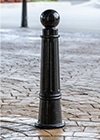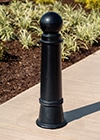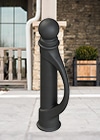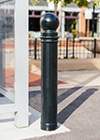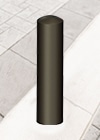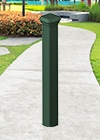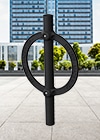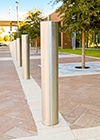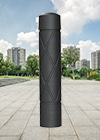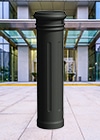When TSW Design Group pitched their vision for a state-of-the-art streetscape to the rural city of Huntingburg, Indiana, city leaders fell in love.
The “flex-system” TSW proposed included removable bollards that would allow the city to turn 4th Street — the main thoroughfare in its historic downtown — into a truly multi-use space fit for any occasion.
TSW created this digital concept video to explain how the system would work.
With the concept settled, TSW moved to the next stage in the project: finding the right bollard manufacturer.

The right capabilities, close to home
In searching for the right product, TSW knew the manufacturer needed to meet two important criteria:
- They needed to be able to accommodate detailed casting and fabrication customization requirements to match the aesthetics and functionality needed for Huntingburg’s downtown revitalization.
- They needed to fall within the budgetary price point and timeline volatility parameters laid forth, without relinquishing quality.
BollardsUSA checked both boxes. And, we offer extensive customizability.
(Are you vetting bollards manufacturers or developing product specifications for an upcoming project? Sharpen your decision-making by reading our in-depth guide.)
Since downtown areas attract heavier crowds, removable bollards were the right choice. They can attach into the sidewalk to create more parking space or out onto the street, so businesses and restaurants may seat guests outdoors.

Our customizability also gave TSW the opportunity to add a final, striking touch to their design: the bollards would feature custom castings of the city’s logo.
From there, it was a matter of working out the specifics with our designers. We helped specify the height, thickness and other details.
However, TSW’s order did not stop at just bollards. Architects also envisioned removable gates for each side of the street entrance that would block vehicular traffic, allowing the city to turn 4th Street into a large event plaza.
Drawing from over a century of iron casting and steel fabrication experience, our design & engineering teams created custom decorative gates that could attach to the bollards themselves, creating an attractive visual barrier that also effectively blocked vehicular traffic. In addition, we custom-fabricated removable, cast-in logo ground plugs to cover mount holes when bollards were not in place.
In the end, BollardsUSA manufactured 129 custom logo caps, 129 rolled steel tube bollards, 40 decorative gates, and 222 custom ground plugs. Every piece was manufactured and shipped directly from our foundry in Middlesboro, Kentucky.

Committed customer collaboration
The project required close collaboration with both the TSW team and Huntingburg officials to bring their vision to life.
For example, BollardsUSA experts worked closely with TSW representatives to supply tangible resources the architects needed to sell their ideas to the municipal steering committee in charge of the project. Along with 3D renderings of the specific, custom product, we provided TSW with physical samples of the logo cap and bollard to present at a committee meeting.
According to one TSW representative, “When we got these (physical samples) and opened them up and the steering committee saw these, that was the final piece that they fell in love with.”
So much so, in fact, that the committee did not require TSW to submit any approved equals for the products they specified, something that’s normally required of most government projects. “Once the look was in place, the steering committee was adamant, ‘We’re going to find a way to make these happen,’ and they did,” the representative said.

Let’s work together to find your perfect product
At BollardsUSA, we know that collaboration is the key to designing and building the perfect bollards or other streetscape fixtures. Here’s how we help you:
- Offering one-on-one communication with our industry experts — no automated phone lines or online form fields, be prepared to discuss budgetary estimates and constraints
- Providing direct and easy access to our design and engineering teams to answer technical questions
- Creating 3D renderings and providing physical samples to help stakeholders better visualize designs
- Fabricating other products like cast-in logo caps, gates and more to ensure all fixtures are unified in their look and feel
To begin working with our team, you can submit a quote from our product page or contact us directly at 1-502-554-1178.

